16 August 2019 marks the bicentenary of the notorious Peterloo Massacre in Manchester. On 16 August 1819, approximately 50,000-60,000 people gathered in St. Peter’s Field to peacefully demand parliamentary reform at a time when fewer than two percent of the British population had the vote. The crowd had come to be addressed by the famous radical orator Henry Hunt but the peaceful demonstration turned into a bloodbath.
Local magistrates called on the Manchester and Salford Yeomanry to arrest Hunt and several others. Along with other militia cavalrymen, regular army soldiers and special constables, the yeomanry charged at the crowd. 18 people were killed and 700 injured in an event that is now viewed as a watershed in British political history.
The public outrage that followed the massacre was hugely influential because it led to the rise, among others, of Chartism and trade unions within Britain as well as the establishment of the Manchester Guardian newspaper, which is now known as The Guardian. It’s ultimate legacy is that it was a powerful symbol for ordinary people in winning the right to vote.
In 1819 and the years that followed, the Peterloo Massacre was potently depicted in contemporary works of art such satirical cartoons, paintings and prints. However, on 27 September 1884 an extraordinary photograph was taken in Failsworth, Lancashire (now Greater Manchester) of 11 elderly survivors. Aged between 79-83, these protestors were still campaigning for better voting rights and proudly posed in front of demonstration posters. It is believed to be the only surviving photograph of protestors who were at Peterloo but it has remained relatively unknown until recently.
A copy was discovered by Mancunian historian and broadcaster Michael Wood in a collection of old local history books that belonged to his father. He gave a lecture this year about the image called ‘The Peterloo Photograph’ as part of Manchester Histories’ bicentenary commemorations. Wood reveals how Peterloo was remembered during his childhood, his own family links to Failsworth and the massacre’s powerful legacy in the city and beyond.
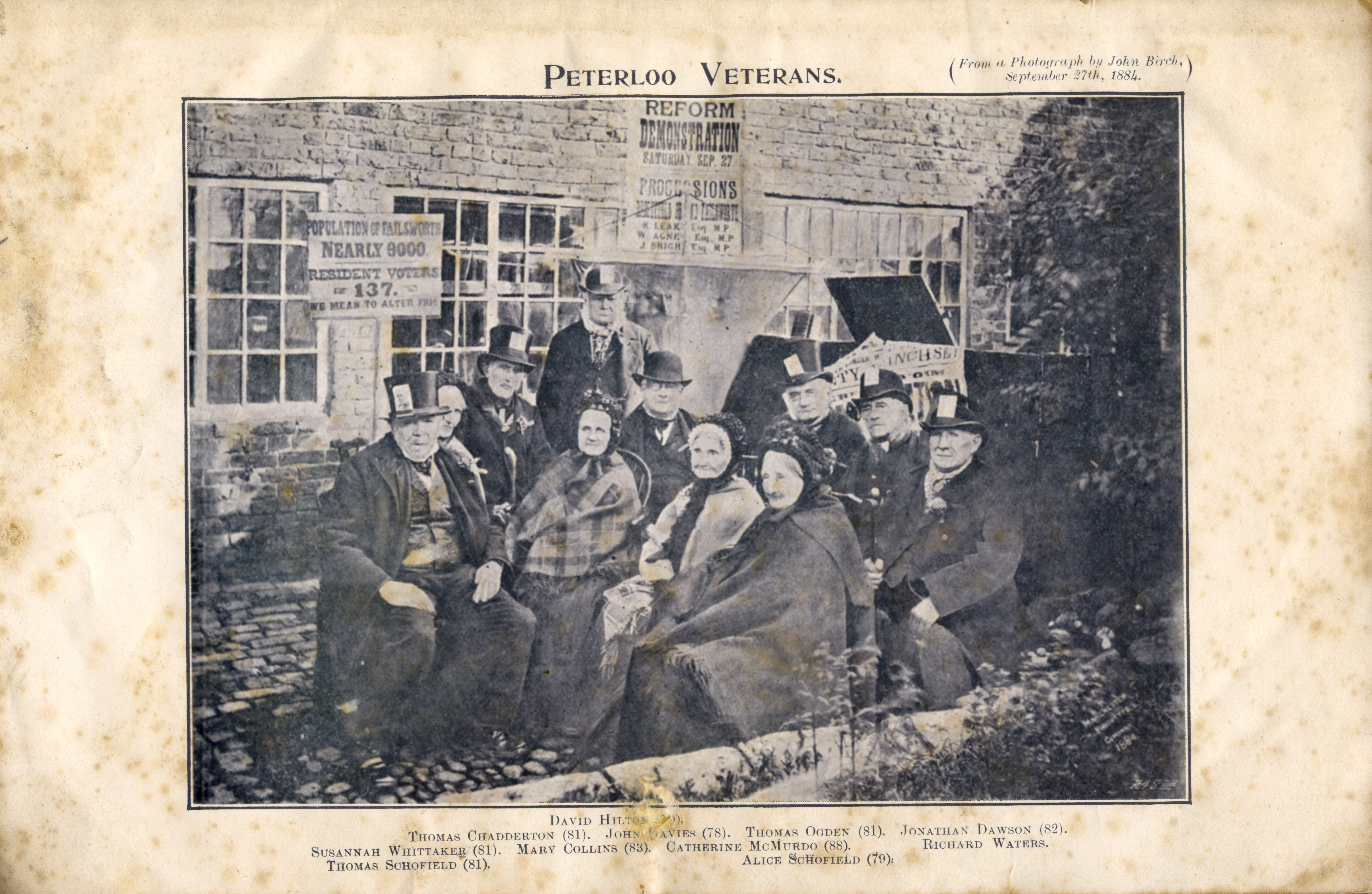
What did the march to St. Peter’s Field say about the condition of Manchester at the time?
There were massive divisions emerging with poverty and unemployment. There had been a whole series of unrest that had been going on: prices were rising and wages were lowering in the four years after Waterloo. These were great economic pressures: the Industrial Revolution was underway and there were a lot of stresses and strains on society. Manchester was also a really difficult place to operate in. There was no civic order and it was still under a manorial ownership. You wouldn’t get a civic order in Manchester until after the 1830s. It was a perfect storm of history and Peterloo was the climactic moment.
How important was the massacre as a political event?
I think it’s very important indeed and historians have talked a lot about this over the years. One historian said that Peterloo was “up there with Magna Carta” so it was a massive moment and everybody recognised it. It was an immense blow and people were just stunned. You had a crowd of 50,000-60,000 and there had been a festive atmosphere. The leadership had instructed the protestors that there was to be absolutely no violence used or any semblance of rioting. There were a large number of women present and Samuel Bamford described many of them as wearing white dresses and frocks with hats and garlands of flowers. The whole atmosphere was like Wakes Week with the festive summer entertainments that they put on in rural districts.
Everybody was therefore totally stunned by what happened and the reaction was from top to bottom. Lord Byron wrote poems about it and when Percy Shelley heard the news in Italy he wrote ‘The Masque of Anarchy’, which has been called the greatest political poem in the English language. Locally, the stunned reaction caused a huge amount of pamphleteering. The government moved against reforming newspapers as often as it could but everybody was writing about it. Alison Morgan has recently published a collection of Peterloo songs and ballads and she’s retrieved about 80-90 of them! These were written in the immediate aftermath and sung in pubs, clubs and taverns. The Manchester Guardian (now The Guardian) was also founded in the aftermath of Peterloo as a liberal paper.
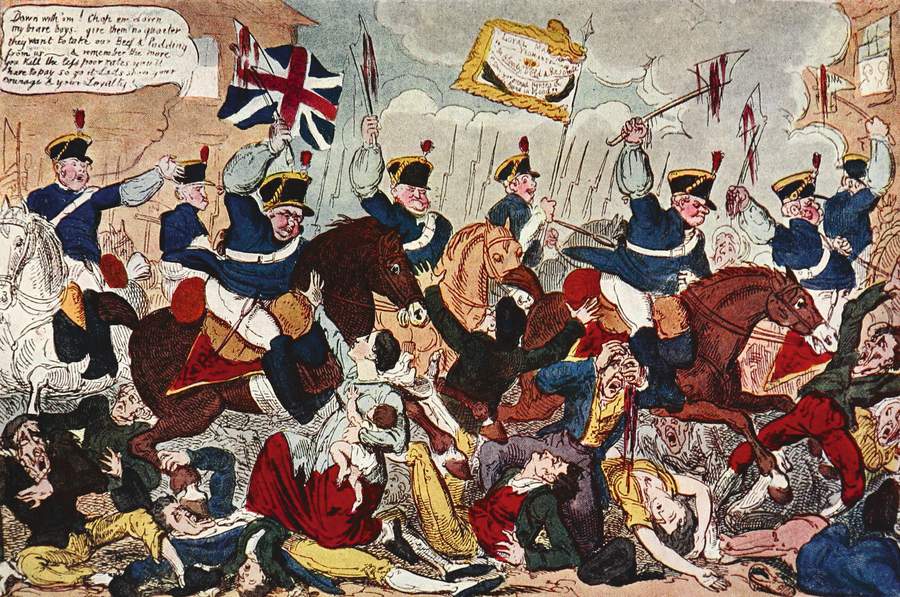
Although 18 were killed and hundreds more injured on 16 August 1819, there were many more people who had died in the recent Napoleonic Wars. Why do you think the memory of the smaller-scale horror of Peterloo has endured?
It was more the fact that the government had actually deployed troops and yeomanry against their own people and struck them down in those circumstances. There had been no provocation, they planned to disperse the crowd violently and they did it. People were of course shocked at the level of violence when it actually happened.
Robert Poole’s new book Peterloo: The English Uprising makes it absolutely clear that the government intended to use violence and were given the go-ahead. About 17-20 were killed and roughly 700 injured, many of them seriously. However, not everybody reported their injuries. My father’s village of Failsworth had people who were afraid of reporting to doctors for fear of being shopped to the police.
It’s therefore more the nature of what happened and people were terribly shocked by the violence towards women. A lot of the women’s groups were also lobbying for rights and there’s quite a lot of suggestion in the sources, eyewitnesses and songs, that the women were deliberately targeted. Some were able to identify members of the yeomanry because they were local to that region. Specific people who committed atrocities are even named in the songs and among the casualty list there is a surprisingly high number of women.
How was Peterloo remembered when you were growing up in Manchester?
I was really surprised to read that Mike Leigh, who directed the film Peterloo and was brought up in Salford, said he’d never heard of the massacre when he was a kid. I was amazed because everybody knew about Peterloo in our neck of the woods. Certainly when I went up to Manchester Grammar School when I was 11 the history teacher made a speech on the first day. He gave us his pen-portrait of Manchester, which was a city of free trade, the Industrial Revolution and the heroes and heroines of Peterloo.
It was definitely something that we all knew about and in my particular case my father came from Failsworth, which played quite a role in the Peterloo story. It was a famous centre of radicalism and it was a really known story in our family because we’ve got ancestors tracing back there to at least the 1790s.
Failsworth was a significantly split community between the radicals after the French Revolution and the High Tory church people. A famous monument called the “Failsworth Pole” was built out of a huge ship’s mast in 1793 by the Tory establishment as an anti-revolutionary symbol with a crown on top. Meanwhile, the local left-wingers, who saluted the French and American Revolutions, opened a Jacobins library on the green opposite the pole. They read Tom Paine’s Rights of Man and other books that were banned and there were very bitter sectarian battles from the 1790s.
When the great contingent from Oldham went to Peterloo in 1819 they gathered on the green in Failsworth in front of the pole, which was the symbol of the establishment. The young girls even put the French ‘Caps of Liberty’ on the leaders of the march before they went to Peterloo. These were bitter class politics that resembled what happened in the pit villages during the Miners’ Strike in 1984 so it’s a really interesting time.
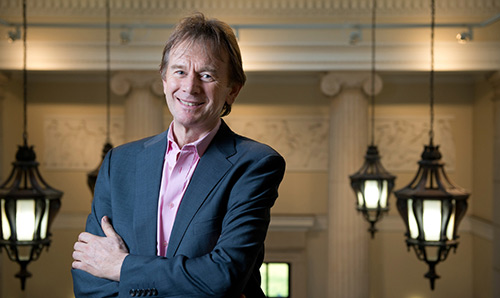
How did a copy of the ‘Peterloo Photograph’ come into your family?
The photograph comes out of this family history because it was taken in 1884, which was 65 years after Peterloo. These were 11 veterans who were youngsters at the time and they were all part of the Failsworth story. Our families were linked to a pool of people, including a few of the veterans, who went to Peterloo who were all neighbours, friends and related by marriage.
I should say that I’m no expert and these are simply family stories. As I was clearing out my mum’s house after she died three years ago, I found a box of books belonging to my dad that included photos and other odd and ends. We wondered why there were these old, obscure local history books of Failsworth among them and they all carried the photograph of the Peterloo veterans. My dad had kept three or four books that contained the picture because it was taken in Failsworth at a prominent event. Consequently, if anybody wrote anything about Failsworth that picture was like a battle honour.
What do we know about the photograph?
The account of the meeting from 1884 says that they carried a banner that they’d carried with Samuel Bamford’s detachment to Peterloo. However, the two banners that you can read was from a demonstration for the vote that they had attended in 1884. There they are in their eighties and they are still fighting! They were still activists and that night they went round a local house for tea where they told stories and sang songs.
How important are photographs like this as historical records?
Photographs sometimes open an amazing window. There is quite a famous photograph in the British Library of a Chartist meeting in 1848 in Kennington and when you have photos like that it’s staggering. They are beyond price as a record of what people were actually like at that time during the early development of photography.
Photos can therefore be absolutely stunning and it’s why I called my talk ‘The Peterloo Photograph’. This is because you may think, “Peterloo? 1819? Photography wasn’t invented then!” But there they are and we know who they were and what they did. They’re no longer anonymous weavers who don’t have any background or can’t be placed. You can situate themselves in their families and culture and they become real people. The fact that they’re in their eighties and still demonstrating shows that they were very committed to what they did. When they were interviewed about their memories on that day in 1884 they were still adamant and clear-minded about a lot of things.
The photograph transforms everything and quite a lot of things in history do that. You just catch those moments, especially during that first period when photographs are being taken. They take you a further step back than you think is possible, which is really great.
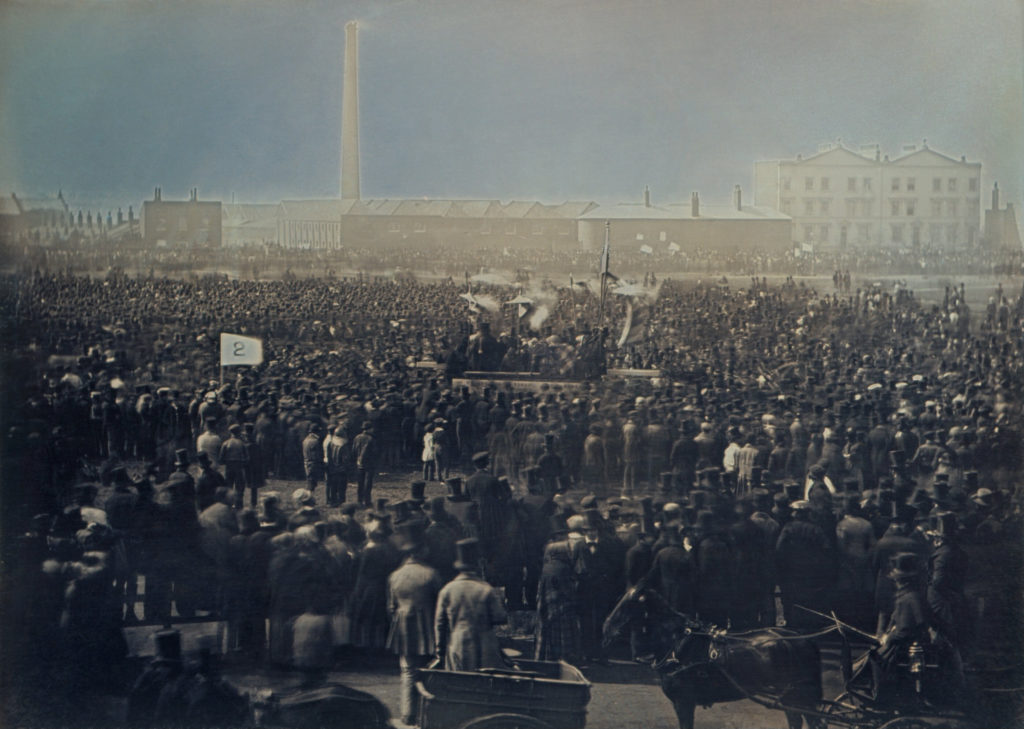
How important are the bicentenary events for Manchester?
I think they are important and Manchester has always had a unique place in history. When you travel in on the train from Stockport it doesn’t have the vibe of a great city of history or a place of destiny. It doesn’t have great vistas like Liverpool or Newcastle: it was a mill town that turned into a city and was also surrounded by mill towns.
However, because of what happened from the Industrial Revolution onwards, it was no mistake that so many movements began there. This included the Suffragettes and Chartism was really big in Manchester. It was a great centre of radical and liberal politics and Friedrich Engels lived there, which is why Karl Marx came up.
It was really the experience of Manchester that led Engels and Marx to construe the nature of capitalism in the way that they did. If Engels had lived in Birmingham, Marx would have seen a completely different kind of industrial society. It was made out of thousands of small workshops and it was a different kind of industrial economy altogether. Their interpretation of history was really influenced by Manchester.
So a lot of really great things happened in Manchester and I think Mancunians are still proud of that. They used to have this advert 15 years ago called “The Original Modern” and in a sense it was the first industrial city. Benjamin Disraeli famously wrote in one his novels, “Considered properly, Manchester is as great an historical exploit as Ancient Athens”. People went there to see the future and so a lot of the battles for rights and liberty took place there as well.
Peterloo is ultimately a symbol: an electric moment after which nothing can be quite the same again. Mancunians still feel that and I think that’s reflective of the pride they have in their city as a crucible of history where things are hammered out.
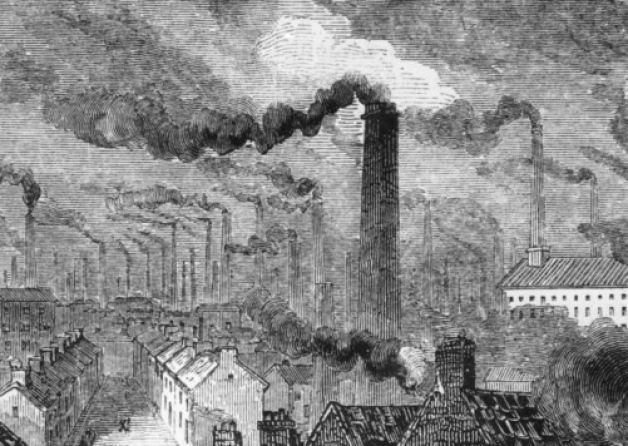
The composer Emily Howard recently said, “There’s a resonance with today – Peterloo is still with us”. To what extent do you think that is true in modern British politics?
I’m not an expert in 19th Century history but the protesters in 1819 were demonstrating for the reform of the political system. That system was of course in the state that it was then and the veterans in the photograph were still campaigning for reform in 1884. On one of those banners it says, “Population of Failsworth: Nearly 9,000. Resident Voters: 137. We Mean To Alter This.” In 1884 the vote was all tied to property but the vote was then gradually extended in the early 20th Century.
However, consider what we have been through recently and are still going through now over Brexit and the traditional political parties. If anyone thinks that the current political system does not need reforming then they are living in a dream world. All kinds of inequalities and injustices in the political system have been bequeathed to us from a long way back and still function.
There was a recent report that said that more than 50 percent of the land in Britain is owned by less than one percent of the people. If you sat down with those 11 Peterloo veterans – 135 years since the photograph was taken and 200 since 1819 – and told them that they would be staggered. Nobody back then thought that the political system was in any way a fixed thing. They needed to fight to reform it on behalf of the rights of the ordinary people and we’ve also really come up against the buffers in the last few years.
Consequently, I think the fallout of these 19th Century events still resonate in our culture. The idea that we’ve somehow reached the pinnacle of being the world’s great democracy with the “Mother of Parliaments” is something that nobody believes anymore. Radical reform is needed and therefore the ghosts of Peterloo still speak to us.
To read more about the legacy of the Peterloo Massacre pick up a copy of All About History Issue 80, which is on sale now. To purchase a subscription visit. www.myfavouritemagazines.co.uk
For more information about Manchester Histories’ Peterloo bicentenary events and activities visit: www.manchesterhistories.co.uk
Image of the Peterloo Photograph courtesy of Michael Wood.